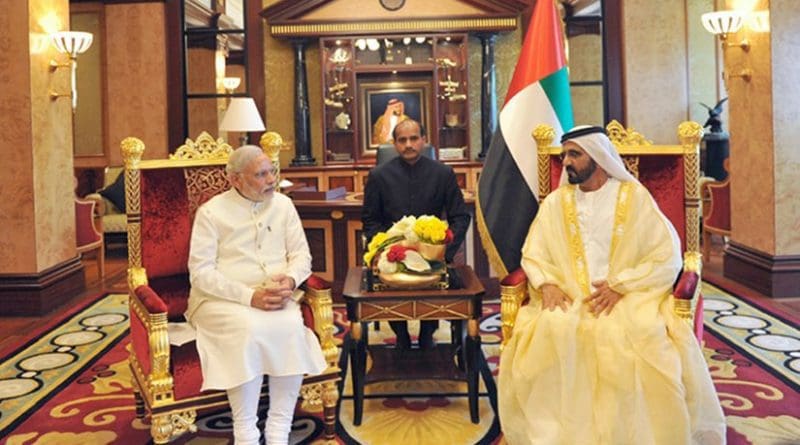The Contours Of India In The Middle Eastern Quad – OpEd
With minilaterlaism ruling the roost in today’s geopolitics and diplomacy, after the in-person head of state Quadrilateral Security dialogue held in Washington DC on 24th September, we witnessed the virtual four-way conversation between External Affairs Minister, Dr S. Jaishankar with his Israeli, UAE and American counterparts during his state visit to Tel Aviv. Given the recent geopolitical events manifesting, this minilateral initiative could indeed turn the tables in this region.
A BACKSTORY OF BILATERAL RELATIONS
Despite India’s solid support for the Palestinian cause, it was in 1992 when the government of PV Narasimha Rao formalized Indo-Israeli bilateral ties. From then, there has been no looking back. The de-hyphenated Israel-Palestine policy adopted by India in 2014 and the hallmark strategic partnership entered into by both countries in 2017 have given a new impetus to this relation. India’s bilateral relations with the UAE from its inception in 1971 has been one of the most vital not only in G2G realms of security and defence cooperation but also in P2P realms of trade, commerce, education, and diaspora. India’s relations with the US widened post-Cold War during the 1991 liberalization phase of the Indian economy. The Indo-US bilateral relationship blossomed with the signing of the 2008 Civil Nuclear Agreement and the 2020 2+2 ministerial dialogue with a broader range of cooperation in the areas of defence, counterterrorism, education, trade, and commerce. The signing of the Abraham Accords between Israel and key Gulf states brokered by the US and minilateral initiatives like the India-UAE-Israel trilateral indicates that this regional initiative is very strategic in the Indian geopolitical matrix.
MULIT-SECTORAL COOPERATION
To quote senior analyst C. Raja Mohan, “The International Federation of Indo-Israeli Chambers of Commerce says combining India’s scale with Israeli innovation and Emirati capital could produce immense benefits to all three countries. Add to this, US support and backing.” This very aptly summarises the trade, innovation and technology opportunities this minilateral opens up. India, for instance, has a trade of $4 billion with Israel, $59 billion with UAE, and $146 billion in the USA with the huge diaspora in each of the countries indeed has excellent commercial potential to leverage. Add American strategic support, and you would see a powerful dynamic unfolding in the region. An article by Prof. Michaël Tanchum in the ISAS South Asia Scan elucidates how this new “Quad” can establish an Indo-Arab-Mediterranean Corridor having a paradigm strategic shift in the connectivity infrastructure of the region. Exercise Blue Flag 2021 also is a positive sign of enhanced defence cooperation this group has witnessed. This grouping can also provide strategic solutions for maintaining regional security and stability especially with Taliban’s resurgence in Kabul.
THE CHINESE ANGLE
The only elephant in the room is China. All four countries have essential economic ties with Beijing, thereby making the four states walk a tight rope on handling in the “Dragon”, especially for the middle eastern nations. With Sino-Israeli Strategic Partnership widening with the 2015 selling of a section of the Hafia Port to the Shanghai Port Group, which was just opposite to a harbour used by the US 6th fleet and the potential Sino-UAE military logistical cooperation as seen in a recent Pentagon report, has ruffled some feathers in the US diplomatic circle. However, initiatives like the Abraham Accord and the new Quad minilatearal have shifted the balance of power back in favour of the US. What better way to complement it than an Indo-Abrahamic bloc as India, as a partner of the US, is playing an active role in the maritime Quad to deter Chinese aggressiveness in the Indo-Pacific along with Japan and Australia.
THE POWER EQUATION OF THE EASTERN MEDITERRANEAN
The Eastern Mediterranean region has emerged as an essential geopolitical entity with the recent discovery of natural gas near its coasts, making global powers like Russia, China and France want to play a key role there. India, too, can leverage this opportunity through this new Quad initiative. Given the recent Turkish “gunboat” diplomacy in the Eastern Mediterranean, President Erdogan’s pro-Pakistan stance on the Kashmir conflict and blocking of India into the NSG group has made India strengthen its bilateral relations, especially on defence issues with countries like Greece, making India treat Turkey more of a geopolitical rival because of its growing partnership with Islamabad. This minilateral forum also gives India a strategic platform to deftly counter the sabre-rattling of Turkey as it can take advantage of the increasing rivalry between Turkey and the Gulf nations due to Turkish ambitions in establishing a new Muslim world order.
THE WAY FORWARD……
With more countries like Saudi Arabia, Egypt and other European nations likely to join this minilateral in the long run, the middle east Quad surely shall be a geostrategic force to reckon with.
*Krishna Ravishankar is a first-year law student at NLU Jodhpur

